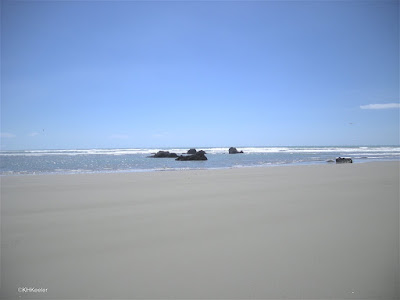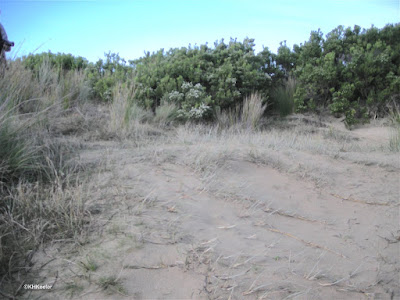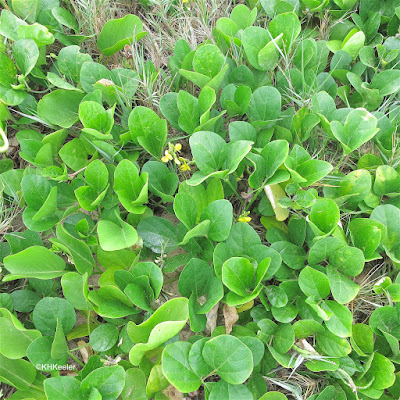 |
| beach in Hawaii |
Our world has more ocean than land, so there are vast coastlines. I live in the center of the second-largest continent, which puts me nearly as far from a coastline as is possible. So of course I'm enchanted by beaches.
 |
| beach in New Zealand |
Mostly, beaches seem like plant-free places. The dictionary calls a beach a pebbly or sandy shore. Ocean-edge cliffs and rocky shores would not count. Whatever slope and substrate is, ocean edges are some of the most difficult environments in the world: unstable and repeatedly flooded.
There are algae that live in the mostly-submerged zones of the shoreline and a few marine flowering plants grow underwater, not on the beach. Even the animals of a sandy beach are generally under the sand, so the environment looks sterile (photo above).
But when you walk to the backbeach, where the ocean only reaches during a storm, you encounter a group of specialist plants. In the photo below, the sand specialists are the grasses coming down the slope (the ocean is behind me).
 |
| Victoria Australia. The grass in the foreground has been buried by the sand |
They have to be tough. On sandy beaches, shifting winds will bury the plants. Or erode all the sand out from under them. This is a better view of beach grasses:
 |
| More grasses, struggling in accumulating sand |
The principles apply to beaches in the Temperate Zone, for example, on the East and West Coast of North America, but as you reach the tropics, the plants change.
This is a typical beach plant of tropical and subtropical beaches, the beach morning glory,
Ipomoea pes-caprae (morning glory family, Convolvulaceae). Like the grasses, it forms long runners, buried in the sand for several inches, then emerging. The species epithet,
pes-caprae means goat's foot, referring to the shape of the leaf.
 |
| beach morning glory in Hawaii |
 |
| beach morning glory, Ipomoea pes-caprae |
Another pantropical beach plant is the beach pea,
Vigna marina (pea family, Fabaceae). If you look carefully, the leaves are in threes as is typical of the pea family, and the yellow flower is a classical bean or pea flower. Like the beach morning glory, this plant is found on tropical beaches around the world, from the Caribbean to India to Hawaii.
 |
| beach pea, Vigna marina |
 |
| beach pea, Vigna marina |
The pan tropical beach specialists grow on beaches all over the tropics and subtropics, even on remote islands, such as Hawaii. The more you think about that, the more remarkable it is. The seeds had to float to those isolated beaches, surviving weeks in salt water without sinking or the salt killing the embryo inside the seed.
The challenge doesn't stop there. Beaches are tough places for seeds to germinate. Then, just because it arrives and germinates on a new beach doesn't mean the seedling will survive. Being buried or bare-rooted by shifting sand is tough for established plants and seedlings have fewer resources. Good periods do happen and seedlings do germinate and establish. But thousands perish, in storm tides or droughts or by burial. That is one of the reasons so many sandy beach plants spread with long runners: the established root system will support the runner if it is buried or exposed. The spot where leaves were can become simply the stem leading to a cluster of leaves in a better spot. Stems of beach morning glory and beach pea are often 10 feet long, in fact the beach morning glory has been recorded with a 90-foot stem.
 |
| Beach morning glory on a beach in southern Taiwan |
It is generally a precarious existence. But the harsh conditions that challenge the beach plants keep taller plants from invading. If coastal conditions keep the backbeach stable, shrubs and trees will germinate, growing up to shade out the beach specialists.
I love to walk sandy beaches. Though I look in vain for flowering plants, I am grateful for the tough conditions that keep them open and plant-free.
 |
Look and enjoy!
Beach on Virgin Gorda, British Virgin Islands |
Comments and corrections welcome.
Kathy Keeler, A Wandering Botanist










No comments:
Post a Comment